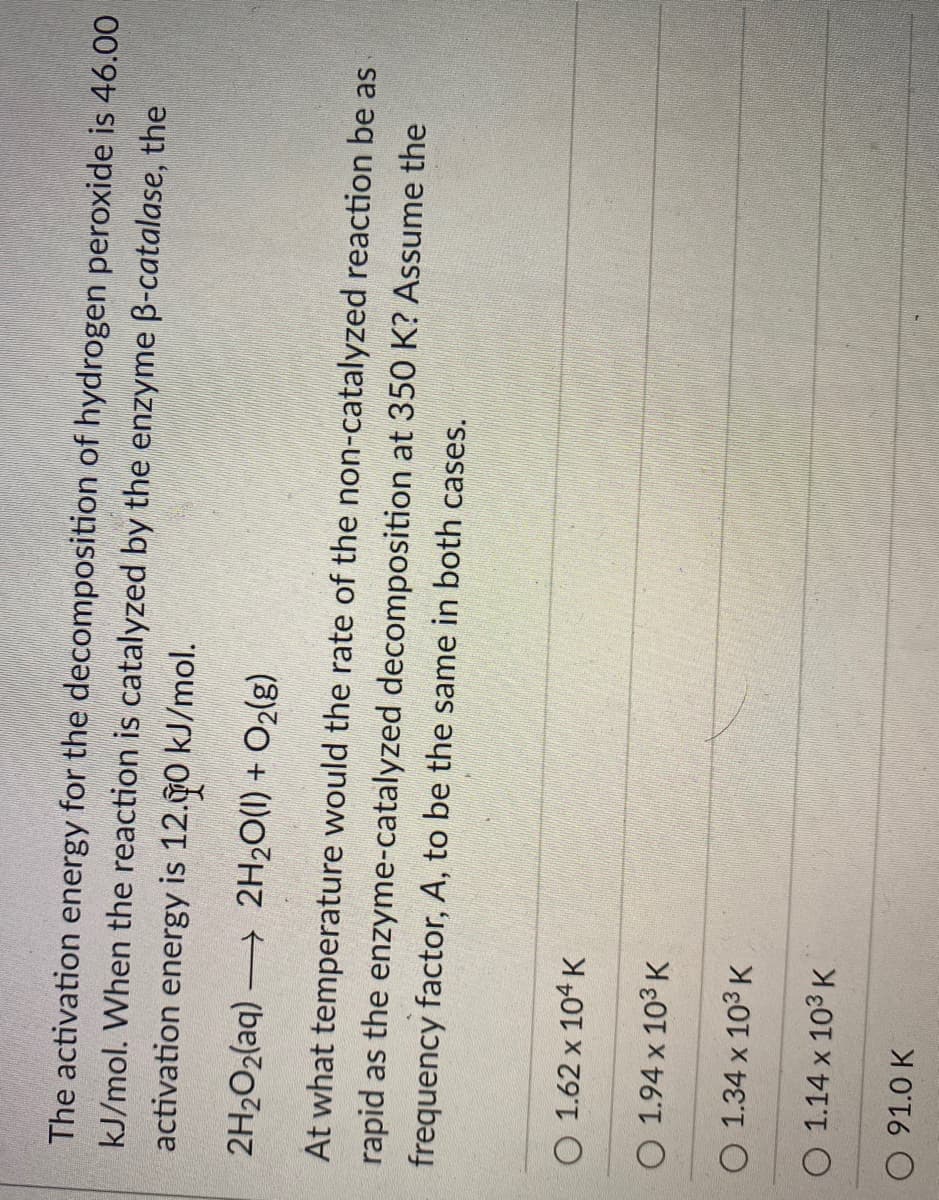r the reaction, 2NO(g) + Cl2(g) - 2NOCI(g), the following data tained at constant temperature: [NO] [C)] Initial rate Experiment (M) (M) (M/s) 1 0.20 0.10 0.63 2 0.20 0.30 5.67 3 0.80 0.10 2.52 4 0.30 0.20 What is the initial rate of reaction for Experiment 4?
r the reaction, 2NO(g) + Cl2(g) - 2NOCI(g), the following data tained at constant temperature: [NO] [C)] Initial rate Experiment (M) (M) (M/s) 1 0.20 0.10 0.63 2 0.20 0.30 5.67 3 0.80 0.10 2.52 4 0.30 0.20 What is the initial rate of reaction for Experiment 4?
Chemistry for Engineering Students
4th Edition
ISBN:9781337398909
Author:Lawrence S. Brown, Tom Holme
Publisher:Lawrence S. Brown, Tom Holme
Chapter11: Chemical Kinetics
Section: Chapter Questions
Problem 11.35PAE: 11.35 For the reaction 2 NO(g) + 2 H?(g) — N,(g) + 2 H,O(g) at 1100°C, the following data have been...
Related questions
Question
![For the reaction, 2NO(g) + Cl2(g) 2NOCI(g), the following data were
obtained at constant temperature:
[NO]
Initial rate
Experiment
(M)
(M)
(M/s)
1
0.20
0.10
0.63
2
0.20
0.30
5.67
3
0.80
0.10
2.52
4
0.30
0.20
What is the initial rate of reaction for Experiment 4?
5.7 M/s
1.9 M/s
6.7 M2s1
3.8 M/s
2.8 M/s](/v2/_next/image?url=https%3A%2F%2Fcontent.bartleby.com%2Fqna-images%2Fquestion%2F04ad1141-e3fe-4631-bced-2c9f6272f5de%2Fd2241e5a-bbd3-4b53-9f14-8f4fe8642a79%2Forfvgoc_processed.jpeg&w=3840&q=75)
Transcribed Image Text:For the reaction, 2NO(g) + Cl2(g) 2NOCI(g), the following data were
obtained at constant temperature:
[NO]
Initial rate
Experiment
(M)
(M)
(M/s)
1
0.20
0.10
0.63
2
0.20
0.30
5.67
3
0.80
0.10
2.52
4
0.30
0.20
What is the initial rate of reaction for Experiment 4?
5.7 M/s
1.9 M/s
6.7 M2s1
3.8 M/s
2.8 M/s

Transcribed Image Text:The activation energy for the decomposition of hydrogen peroxide is 46.00
kJ/mol. When the reaction is catalyzed by the enzyme B-catalase, the
activation energy is 12.0 kJ/mol.
2H202(aq) 2H20(1) + O2(g)
At what temperature would the rate of the non-catalyzed reaction be as
rapid as the enzyme-catalyzed decomposition at 350 K? Assume the
frequency factor, A, to be the same in both cases.
O 1.62 x 104 K
O 1.94 x 103 K
O 1.34 x 103 K
O 1.14 x 103 K
O 91.0 K
Expert Solution
This question has been solved!
Explore an expertly crafted, step-by-step solution for a thorough understanding of key concepts.
This is a popular solution!
Trending now
This is a popular solution!
Step by step
Solved in 10 steps

Knowledge Booster
Learn more about
Need a deep-dive on the concept behind this application? Look no further. Learn more about this topic, chemistry and related others by exploring similar questions and additional content below.Recommended textbooks for you

Chemistry for Engineering Students
Chemistry
ISBN:
9781337398909
Author:
Lawrence S. Brown, Tom Holme
Publisher:
Cengage Learning

Chemistry: The Molecular Science
Chemistry
ISBN:
9781285199047
Author:
John W. Moore, Conrad L. Stanitski
Publisher:
Cengage Learning

Chemistry: Matter and Change
Chemistry
ISBN:
9780078746376
Author:
Dinah Zike, Laurel Dingrando, Nicholas Hainen, Cheryl Wistrom
Publisher:
Glencoe/McGraw-Hill School Pub Co

Chemistry for Engineering Students
Chemistry
ISBN:
9781337398909
Author:
Lawrence S. Brown, Tom Holme
Publisher:
Cengage Learning

Chemistry: The Molecular Science
Chemistry
ISBN:
9781285199047
Author:
John W. Moore, Conrad L. Stanitski
Publisher:
Cengage Learning

Chemistry: Matter and Change
Chemistry
ISBN:
9780078746376
Author:
Dinah Zike, Laurel Dingrando, Nicholas Hainen, Cheryl Wistrom
Publisher:
Glencoe/McGraw-Hill School Pub Co

Chemistry & Chemical Reactivity
Chemistry
ISBN:
9781133949640
Author:
John C. Kotz, Paul M. Treichel, John Townsend, David Treichel
Publisher:
Cengage Learning

Chemistry & Chemical Reactivity
Chemistry
ISBN:
9781337399074
Author:
John C. Kotz, Paul M. Treichel, John Townsend, David Treichel
Publisher:
Cengage Learning

Chemistry by OpenStax (2015-05-04)
Chemistry
ISBN:
9781938168390
Author:
Klaus Theopold, Richard H Langley, Paul Flowers, William R. Robinson, Mark Blaser
Publisher:
OpenStax